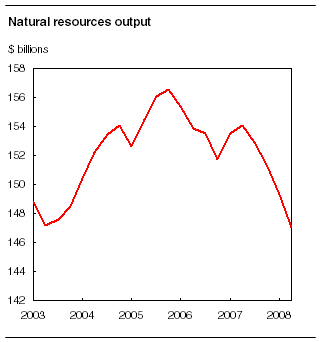Common menu bar links
Study: The role of natural resources in Canada's economy
Archived Content
Information identified as archived is provided for reference, research or recordkeeping purposes. It is not subject to the Government of Canada Web Standards and has not been altered or updated since it was archived. Please "contact us" to request a format other than those available.

The seven-year-old boom in commodity prices has had a large impact on key sectors of Canada's economy, buttressing export earnings and profits.
In response, companies substantially increased fixed investment in the resource sector, although they have had a surprisingly small impact on the recent growth of output and employment.
Resources were also the leading factor in lifting the stock market to record heights, while attracting direct foreign investment flows into Canada. However, these increases have been partly reversed as commodity prices fell in response to the recent turmoil in global financial markets.
Not all resources have participated equally in the commodity-price boom. Energy recorded the largest and most sustained increases, led by crude oil. Metal prices took the lead in 2006 and 2007, but more recently have pulled back.
Grain prices jumped in 2007 and early 2008, but have eased on the prospect of a good harvest. The boom bypassed the forestry sector in recent years, due to falling demand for lumber and newsprint.
Exports and business investment
The commodity-price boom has had a large impact on both the structure and growth of exports. So far in 2008, nominal exports of natural resources have accounted for nearly 65% of all goods exports, up from 45% in 2002. The increase was especially pronounced in 2008, reflecting record energy prices.
The trade surplus in energy products alone has been equal to all of Canada's merchandise trade surplus since the second quarter of 2006. Canada also runs surpluses in trade for all other resource products.
Since 2004, natural resources have accounted for all of the growth in Canada's export earnings. Resource exports increased by one-third from about $20 billion in 2003 to $31 billion (at annual rates) so far this year through August. Over the same period, non-resource exports fell 17%, notably for automotive products.
Since 2002, business investment in structures and equipment by the resource sector has increased faster than in the rest of the economy. This raised the share of natural resource industries from 36% to nearly 44%, the highest on record. Energy consistently led this increase, driven by the oil sands, although more recently metal mines saw rapid gains.
Output and employment
The resource boom since 2003 reflected primarily higher prices. Real gross domestic product (GDP) in the resource sector has fallen slightly since the fourth quarter of 2002.
Output in resources initially rose in response to higher prices, gaining 6% by the end of 2005. Since then it has fallen steadily, with mining output particularly weak over the past year.
The drop in resource output after 2005, despite record prices and profitability, reflects a number of factors. Some sectors cut output sharply due to weak prices, notably forestry where output fell by over a third.

However, not even the energy and metal mining industries have been able to boost output. Partly, this is due to the depletion of the most productive sources.
Every dollar of output in the resource sector generates another 69 cents of GDP. The largest of these spin-off effects is within oil and gas, as most resource industries are energy-intensive. Other industries that see high spin-off effects are finance, trade, business services and transportation.
All told, the direct and indirect impact of resource output was equivalent to 22% of all GDP.
Natural resources have not been a large source of jobs for Canadians this decade. Partly this reflects their capital-intensive production process.
As a result, the share of employment in natural resources industries has hovered around 7% since 2000. Still, this represents a levelling off after a rapid decline during the 1990s from near 10% in 1990. Of course, the importance of resources is much higher in some provinces.
Definitions, data sources and methods: survey numbers, including related surveys, 1401, 2198, 2202, 2203 and 2301.
The study, "The role of natural resources in Canada's economy," is included in the November 2008 Internet edition of the Canadian Economic Observer, Vol. 21, no. 11 (11-010-XWB, free), now available from the Publications module of our website. The monthly paper version of the Canadian Economic Observer, Vol. 21, no. 11 (11-010-XPB, $25/$243), will be available on November 20.
For more information about the Canadian Economic Observer, click on our banner ad from the Publications module of our website.
For more information, or to enquire about the concepts, methods or data quality of this release, contact Philip Cross (613-951-9162; ceo@statcan.gc.ca), Current Economic Analysis Division.

